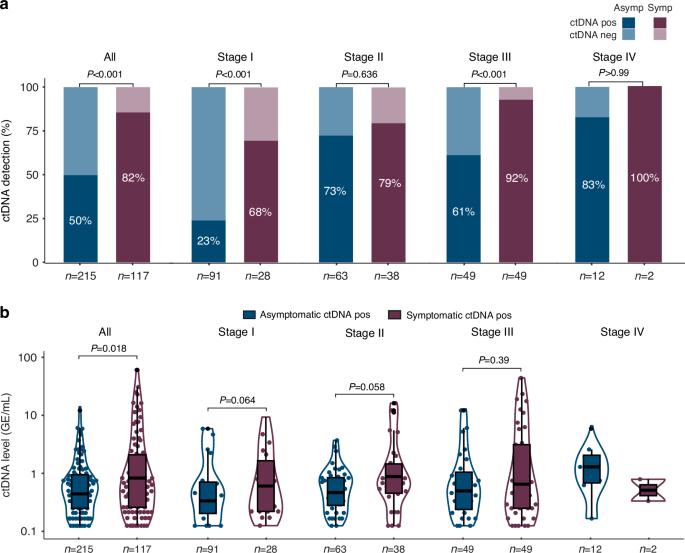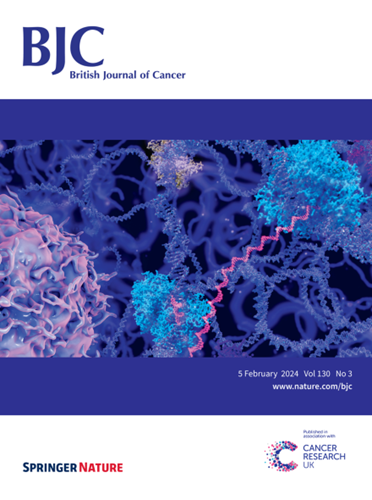无症状与有症状结直肠癌患者的循环肿瘤 DNA 与复发风险。
IF 6.4
1区 医学
Q1 ONCOLOGY
引用次数: 0
摘要
背景:多项研究旨在开发循环肿瘤 DNA(ctDNA)检测方法,用于无症状人群的早期癌症检测。对无症状和有症状患者进行ctDNA检测的少数研究报告显示,无症状患者的ctDNA检测率较低。在此,我们探讨了无症状患者与有症状患者是否存在差异,例如是否包括 "低ctDNA脱落 "和 "侵袭性较低 "的亚组。方法:对连续招募的无症状结直肠癌(CRC)(Cohort#1:n = 215,Cohort#2:n = 368)和有症状结直肠癌(CRC)(Cohort#1:n = 117,Cohort#2:n = 722)患者的两个独立队列进行ctDNA评估:调整肿瘤分期和大小后,无症状患者检测到ctDNA的几率明显低于有症状患者(队列#1:OR:0.4,95%CI:0.2-0.8;队列#2:OR:0.7,95%CI:0.5-0.9)。此外,无症状患者的复发风险较低(队列#1:sHR:0.6,95%CI:0.3-1.2;队列#2:sHR:0.6,95%CI:0.4-1.0)。值得注意的是,与无症状患者相比,ctDNA阴性的无症状患者复发风险最低(队列#1:sHR:0.2,95%CI:0.1-0.6;队列#2:sHR:0.3,95%CI:0.2-0.6):我们的研究表明,无症状患者中富含 "低ctDNA脱落-低复发风险 "亚群。我们的研究表明,无症状患者中富含 "低ctDNA脱落、低复发风险 "亚群,需要这样的见解来指导基于ctDNA的早期检测措施,并应促使对ctDNA阴性的无症状CRC患者进行降级治疗和随访的讨论。本文章由计算机程序翻译,如有差异,请以英文原文为准。

Circulating tumour DNA and risk of recurrence in patients with asymptomatic versus symptomatic colorectal cancer
Multiple initiatives aim to develop circulating tumour DNA (ctDNA) tests for early cancer detection in asymptomatic individuals. The few studies describing ctDNA-testing in both asymptomatic and symptomatic patients report lower ctDNA detection in the asymptomatic patients. Here, we explore if asymptomatic patients differ from symptomatic patients e.g. by including a ‘low-ctDNA-shedding’ and ‘less-aggressive’ subgroup. ctDNA assessment was performed in two independent cohorts of consecutively recruited patients with asymptomatic colorectal cancer (CRC) (Cohort#1: n = 215, Cohort#2: n = 368) and symptomatic CRC (Cohort#1: n = 117, Cohort#2: n = 722). After adjusting for tumour stage and size, the odds of ctDNA detection was significantly lower in asymptomatic patients compared to symptomatic patients (Cohort#1: OR: 0.4, 95%CI: 0.2–0.8, Cohort#2: OR: 0.7, 95%CI: 0.5–0.9). Further, the recurrence risk was lower in asymptomatic patients (Cohort#1: sHR: 0.6, 95%CI: 0.3–1.2, Cohort#2: sHR: 0.6, 95%CI: 0.4–1.0). Notably, ctDNA-negative asymptomatic patients had the lowest recurrence risk compared to the symptomatic patients (Cohort#1: sHR: 0.2, 95%CI: 0.1–0.6, Cohort#2: sHR: 0.3, 95%CI: 0.2–0.6). Our study suggests that asymptomatic patients are enriched for a ‘low-ctDNA-shedding-low-recurrence-risk’ subgroup. Such insights are needed to guide ctDNA-based early-detection initiatives and should prompt discussions about de-escalation of therapy and follow-up for ctDNA-negative asymptomatic CRC patients.
求助全文
通过发布文献求助,成功后即可免费获取论文全文。
去求助
来源期刊

British Journal of Cancer
医学-肿瘤学
CiteScore
15.10
自引率
1.10%
发文量
383
审稿时长
6 months
期刊介绍:
The British Journal of Cancer is one of the most-cited general cancer journals, publishing significant advances in translational and clinical cancer research.It also publishes high-quality reviews and thought-provoking comment on all aspects of cancer prevention,diagnosis and treatment.
 求助内容:
求助内容: 应助结果提醒方式:
应助结果提醒方式:


